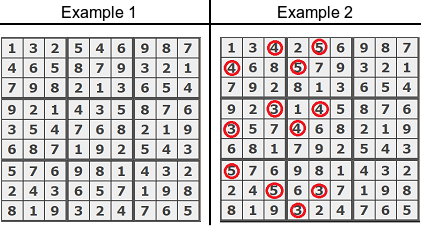Sudoku
Sudoku is a number-placement puzzle. The objective is to fill a 9 × 9 grid with digits so that each column, each row, and each of the nine 3 × 3 sub-grids that compose the grid contains all of the digits from 1 to 9.
This algorithm should check if the given grid of numbers represents a correct solution to Sudoku.
Example
- For
grid = [[1, 3, 2, 5, 4, 6, 9, 8, 7],
[4, 6, 5, 8, 7, 9, 3, 2, 1],
[7, 9, 8, 2, 1, 3, 6, 5, 4],
[9, 2, 1, 4, 3, 5, 8, 7, 6],
[3, 5, 4, 7, 6, 8, 2, 1, 9],
[6, 8, 7, 1, 9, 2, 5, 4, 3],
[5, 7, 6, 9, 8, 1, 4, 3, 2],
[2, 4, 3, 6, 5, 7, 1, 9, 8],
[8, 1, 9, 3, 2, 4, 7, 6, 5]]the output should be
sudoku(grid) = true- For
grid = [[1, 3, 2, 5, 4, 6, 9, 2, 7],
[4, 6, 5, 8, 7, 9, 3, 8, 1],
[7, 9, 8, 2, 1, 3, 6, 5, 4],
[9, 2, 1, 4, 3, 5, 8, 7, 6],
[3, 5, 4, 7, 6, 8, 2, 1, 9],
[6, 8, 7, 1, 9, 2, 5, 4, 3],
[5, 7, 6, 9, 8, 1, 4, 3, 2],
[2, 4, 3, 6, 5, 7, 1, 9, 8],
[8, 1, 9, 3, 2, 4, 7, 6, 5]]the output should be
sudoku(grid) = falseThe output should be false: each of the nine 3 × 3 sub-grids should contain all of the digits from 1 to 9. These examples are represented on the image below.
 |
|---|
| Image Credit : Code Signal |
Input/Output
[input] array.array.integer grid
A matrix representing
9 × 9grid already filled with numbers from1to9.Guaranteed constraints:
grid.length = 9,grid[i].length = 9,1 ≤ grid[i][j] ≤ 9.
Solution
py
def sudoku(grid):
# check each row for duplicates
for row in grid:
if len(row) != len(set(row)):
return False
# check each column for duplicates
for i in range(len(grid)):
col = [row[i] for row in grid]
if len(col) != len(set(col)):
return False
# create 3x3 2D matrix as a flat 1D and check for duplicate
for row in range(0, 9, 3):
for col in range(0, 9, 3):
f = []
for i in range(row, row + 3):
for j in range(col, col + 3):
f.append(grid[i][j])
if len(f) != len(set(f)):
return False
return True
print(sudoku([
[1, 2, 3, 4, 5, 6, 7, 8, 9],
[1, 2, 3, 4, 5, 6, 7, 8, 9],
[1, 2, 3, 4, 5, 6, 7, 8, 9],
[1, 2, 3, 4, 5, 6, 7, 8, 9],
[1, 2, 3, 4, 5, 6, 7, 8, 9],
[1, 2, 3, 4, 5, 6, 7, 8, 9],
[1, 2, 3, 4, 5, 6, 7, 8, 9],
[1, 2, 3, 4, 5, 6, 7, 8, 9],
[1, 2, 3, 4, 5, 6, 7, 8, 9]
]))js
function sudoku(grid) {
// check each row for duplicates
for (let row of grid) {
if (row.length !== new Set(row).size) {
return false;
}
}
// check each column for duplicates
for (let i = 0; i < grid.length; i++) {
let col = [];
for (let j = 0; j < grid.length; j++) {
col.push(grid[j][i]);
}
if (col.length !== new Set(col).size) {
return false;
}
}
// create 3x3 2D matrix as a flat 1D and check for duplicate
for (let row = 0; row < 9; row += 3) {
for (let col = 0; col < 9; col += 3) {
let f = [];
for (let i = row; i < row + 3; i++) {
for (let j = col; j < col + 3; j++) {
f.push(grid[i][j]);
}
}
if (f.length !== new Set(f).size) {
return false;
}
}
}
return true;
}
console.log(
sudoku([
[1, 2, 3, 4, 5, 6, 7, 8, 9],
[1, 2, 3, 4, 5, 6, 7, 8, 9],
[1, 2, 3, 4, 5, 6, 7, 8, 9],
[1, 2, 3, 4, 5, 6, 7, 8, 9],
[1, 2, 3, 4, 5, 6, 7, 8, 9],
[1, 2, 3, 4, 5, 6, 7, 8, 9],
[1, 2, 3, 4, 5, 6, 7, 8, 9],
[1, 2, 3, 4, 5, 6, 7, 8, 9],
[1, 2, 3, 4, 5, 6, 7, 8, 9],
])
);
